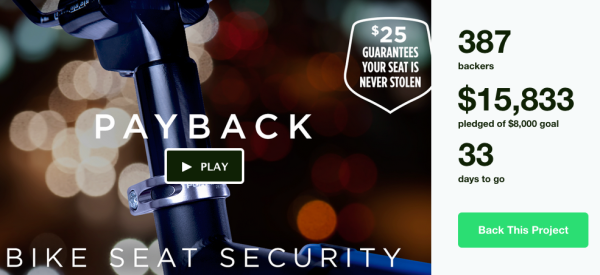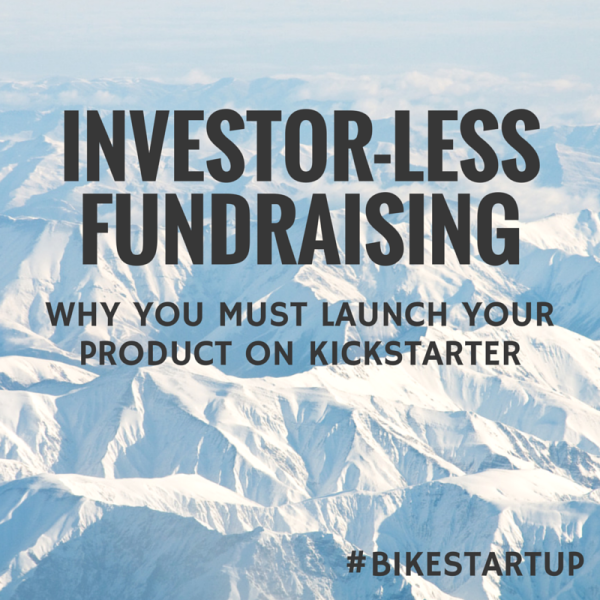#BIKESTARTUP is a scrappy, in-the-trenches guide designed to turn your idea into a full-fledged bike business. We’ve covered customer research, prototyping, and manufacturing. Now let’s talk money.
We’ve been a promiscuous startup. In our seed round, we raised money from two rockstar VCs and sixteen angel investors, which include a mix of serial entrepreneurs, friends, and even two wonderful customers. If you asked me behind closed doors what we think of our investors we’d say, “We love them: they’re champions, mentors, and turbochargers.” Because it’s true.
But you know whom we love more?
Our customers. You see, our customers put $300K into two Kickstarter projects and they…
- validated our products before we even started production
- gave us ideas and showed us what product to build next
- supercharged our marketing by becoming early evangelists
We’ve discussed the second and third bullet points before, so I’ll expand a bit on the first one, then dive into the three key elements to a kickass Kickstarter…
1. Let consumer validate your product first
Do you know what sucks more than having a warehouse full of product nobody wants? Realizing you paid hundreds of thousands of dollars for that product that no one wants and there’s no way you’ll ever recoup that. Crowdfunding vets your product before you contract with a manufacturer to produce 100,000 units of something and shell out many multiples of that to have them make it.
2. Get the money before you produce anything
For most startups, this is backwards, but it’s so much better. Not only do you get approval for your concept, you get the money to produce it from your future customers. And the best part is, they don’t take equity – they pre-purchase product. VCs call this non-dilutive financing. If you’re launching a consumer product it’s one of the biggest reasons you’d be crazy not to use Kickstarter.
Sold? Good. Now here are three key elements to a Kickass Kickstarter…
1. Get emotional with your story
Most Kickstarters don’t tell a story – they simply say, “here’s my gadget. Aren’t these gadgets nifty? Please support me.”
A great Kickstarter project makes you feel something. In the book Made To Stick: Why Some Ideas Survive and Others Die, authors Chip and Dan Heath write, “a credible idea makes people believe, an emotional idea makes people care.”
We struggled with this on our third Kickstarter project: how do you make an anti-theft bike seatpost evoke emotion? We tapped into the emotion of city cycling – the fear when you’re buzzed by a SUV, the rush of breezing past gridlocked traffic, and the outrage of having your bike and accessories ripped off. We had our Eureka! moment when our friend Max had his bike seat stolen. We found the thief selling it on Craigslist, caught him, and filmed it all. Check out the emotion in our third Kickstarter video:

2. Get high with a little help from your friends
A successful Kickstarter launch creates a movement, and a movement starts with a core. Your friends are that core. Too many entrepreneurs make the mistake of keeping quiet about their Kickstarter project – perhaps sharing it on social media the day of the launch. Call it modesty or insecurity; it’s the wrong approach.
Your friends and family love you and love watching you succeed. It’s easier to ask for support when they’re excited about your company and nothing works better than a launch party. We threw a bike-hipster costume party on a Saturday then hosted a Monday morning bacon, waffle, and mimosa party at our co-working office. We counted down from ten, pressed launch, and had thousands of dollars of support from friends within hours.
3. Get lucky with media
Once you have a great product and an emotion-evoking story, it’s time to share it with the world. You can’t afford a PR company, but you can generate your own press with connections, persistence, and luck.
We started months in advance engaging with our favorite blogs and media outlets through article comments and on Twitter. In the week leading up to the project launch, we emailed more than one hundred journalists. The response was deafeningly quiet but the day we launched at least twelve journalists wrote about our product and helped spread our story.
Of course, none of this matters if you didn’t follow these steps to making a bike product cyclists will love.
In the next article we’ll talk about the art and science of sales and distribution. In the meantime ask us questions. We’ll answer every single one of them.
Slava Menn is a serial entrepreneur and CEO of Fortified Bicycle. He loves biking, building, entrepreneuring, and teaching. In this monthly series, he shares his team’s hard-learned startup lessons with aspiring entrepreneurs.
